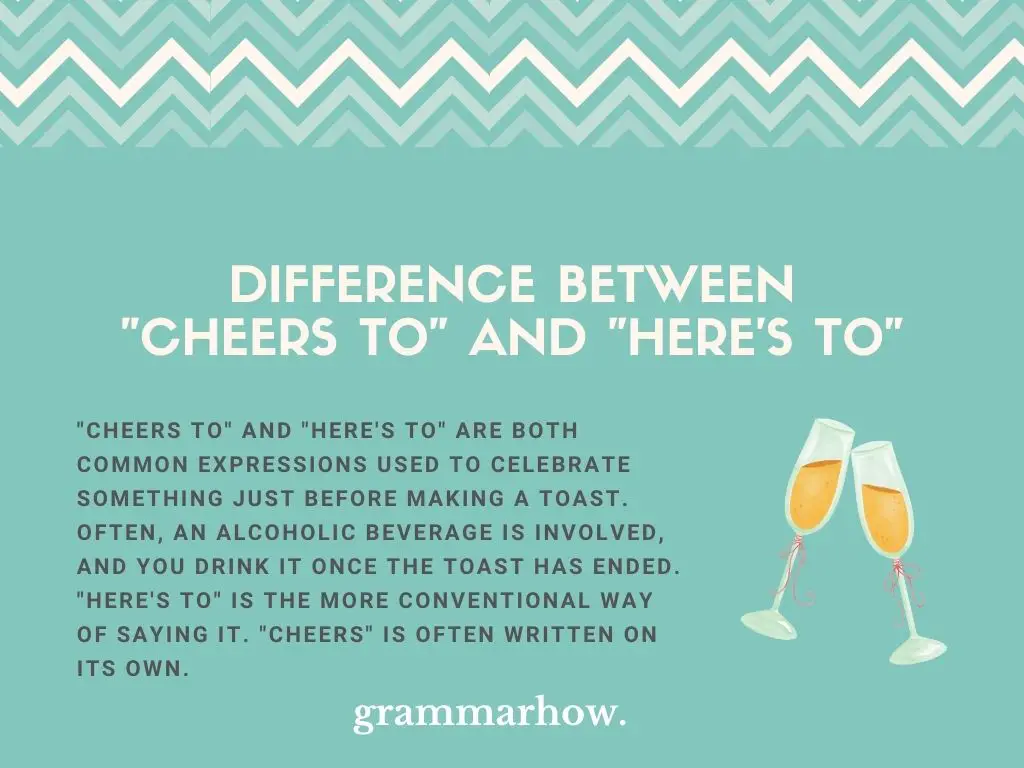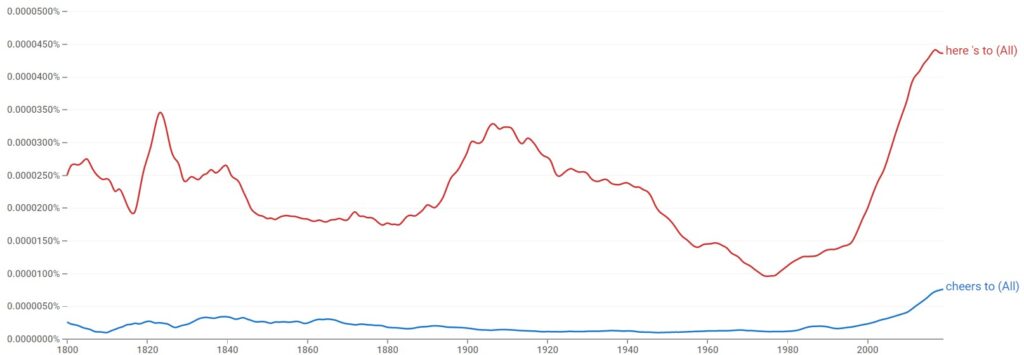Many people are happy to celebrate things in their own way. Paying respect to certain things can be done with similar phrases like “cheers to” or “here’s to.” This article will explain the differences between these two phrases to help you figure them out.
Difference Between “Cheers To” and “Here’s To”
“Cheers to” and “here’s to” are both common expressions used to celebrate something just before making a toast. Often, an alcoholic beverage is involved, and you drink it once the toast has ended. “Here’s to” is the more conventional way of saying it. “Cheers” is often written on its own.

The two phrases are interchangeable as they both relate to making a toast. You would be able to raise your glass in the air at a table and say either of the following:
- Here’s to my father and all the work he’s put in.
- Cheers to my mother for being there for us yet again.
Both of these toasts are grammatically correct. “Here’s” and “cheers” are interchangeable, but “here’s” tends to be the more common option. It’s preferred in standard and spoken English.
Here’s To
“Here’s to” is a common way of introducing a toast. Most people will use this phrase when they want to dedicate a toast or message to a particular group of people. It’s customary to drink an alcoholic beverage after toasting someone and starting with “here’s to.”
After “to,” it’s common to list the people or things that you’re making a toast to. There aren’t many rules associated with what you can and can’t put in a toast. You are able to toast absolutely anything that might have been good in your life:
- Here’s to you
- Here’s to me
- Here’s to them
- Here’s to the company
- Here’s to my health
- Here’s to the good news
The definition of “here’s to,” according to The Cambridge Dictionary, is “said when asking a group of people to hold up their glasses and then drink as an expression of good wishes to someone or hope for the success of something.”
If you want to see how to use “here’s to” in a sentence, you can refer to the following examples:
- Here’s to you and your family! May they find the happiness they deserve in their new ventures!
- Here’s to you, man! I have always believed in you, and I know you’re going to go far in your new life!
- Here’s to the people that couldn’t be with us at the table today. May they live on in our memory for as long as we live.
- Here’s to our friends and family that couldn’t be here! Hopefully, we’ll all see them again soon.
- Here’s to Michael for managing to qualify for the tournament. We always knew he was going to amount to something special.
- Here’s to you! I’m so proud of you, and I hope you continue making progress in the field. You deserve it.
- Here’s to everyone that managed to come here today. We couldn’t have done half as well as we have without all of you.
Cheers To
“Cheers to” is a good way of introducing a toast, but it’s more informal than “here’s to.” Most people only use “cheers” without the prepositional form of “to.” They don’t often direct their “cheers” toward people, but they will say it as a response to someone else’s toast.
Nevertheless, you can still use “cheers to” when you are introducing a toast. It works better informally, though. Make sure you are surrounded by friends and family in a more informal setting if you’re going to use it.
The same endings can apply to “cheers to” as with “here’s to.” You can pick anything to you might want to toast:
- Cheers to you
- Cheers to me
- Cheers to her
- Cheers to the hospital
- Cheers to good fortune
- Cheers to television
The definition of “cheers to,” according to The Cambridge Dictionary, is “a friendly expression said just before you drink an alcoholic drink.”
Here’s how to use “cheers to” in a sentence:
- Cheers to you and all of the people in your circle! We always knew you were destined for genuine greatness.
- Cheers to you, then! I hope this isn’t the last time that we’ll have a chance to meet each other.
- Cheers to everyone that couldn’t be here today. I’m sure they all had good reasons, and I hope we can meet again.
- Cheers to the success of this company and everything it stands for! We can’t wait to see what happens next.
- Cheers to you all! I’m so proud to call you my best friends. I hope we are able to keep this up forever.
Also, “cheers” is often used on its own. A preposition doesn’t need to come after it, and the following examples will demonstrate how a toast might look in this format:
- Cheers! I hope you all have a lovely meal. I can’t wait to get stuck into it.
- Cheers! I’m so glad we could all gather here today to celebrate the life of my late grandmother.
Which Is Used The Most?
According to Google Ngram Viewer, “here’s to” is the most popular choice of the two. There isn’t much competition between the two, showing that “here’s to” is the standard choice that most native speakers will stick with when they are making a toast.

As mentioned, “cheers” is much better on its own. It doesn’t often require a proposition because it’s seen as a more informal and conversational way of celebrating something. It’s often meant as a reply rather than an introduction to a toast.
“Cheers” will often be used to reply to a “here’s to” statement:
- Here’s to our family!
- Cheers!
Is It “Cheers To” or “Cheers For”?
“Cheers to” is correct when you are referencing a group of people or a thing that deserves praise or recognition. “Cheers for” is correct when you are thanking someone for doing something specifically for you. You should use “for” to accept a gift of some kind.
- Cheers to you for being there for me when I need you the most.
- Cheers for the alcohol! I hope we’ll be able to crack this open before the party.
You may also like:
“Here’s To Someone/Something” – Meaning & Examples

Martin holds a Master’s degree in Finance and International Business. He has six years of experience in professional communication with clients, executives, and colleagues. Furthermore, he has teaching experience from Aarhus University. Martin has been featured as an expert in communication and teaching on Forbes and Shopify. Read more about Martin here.
